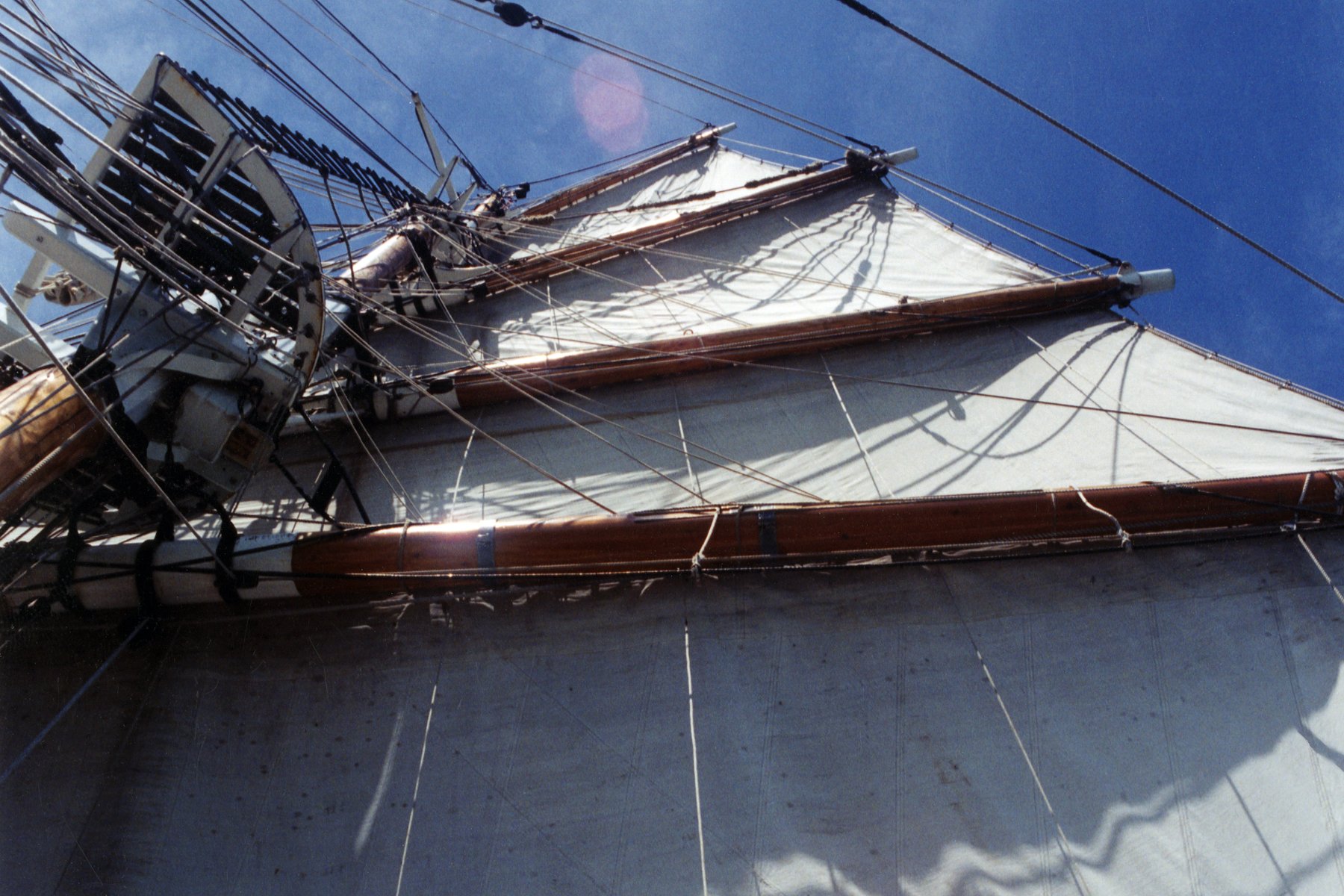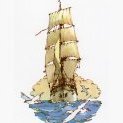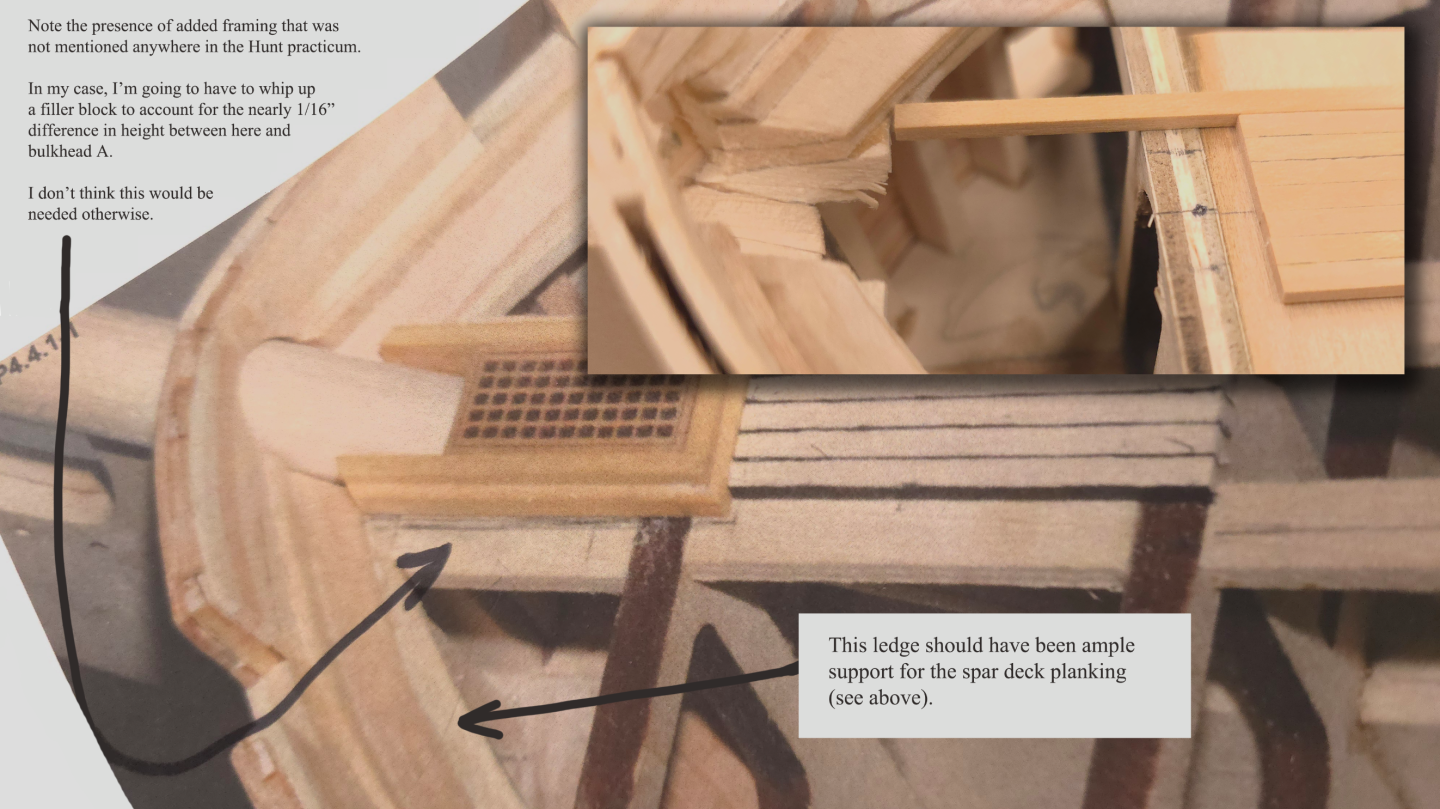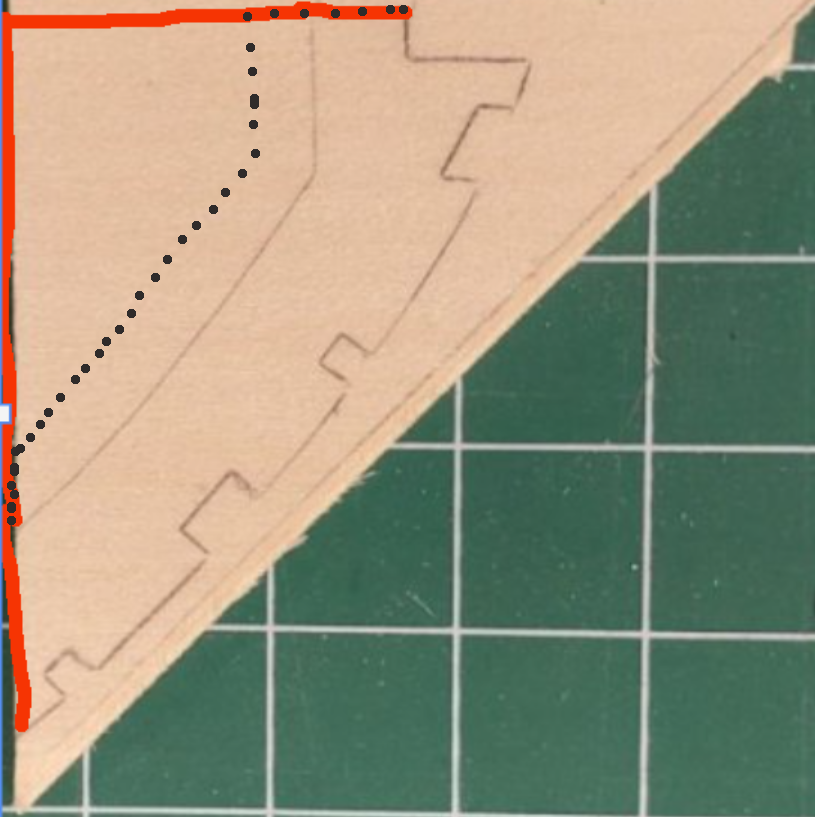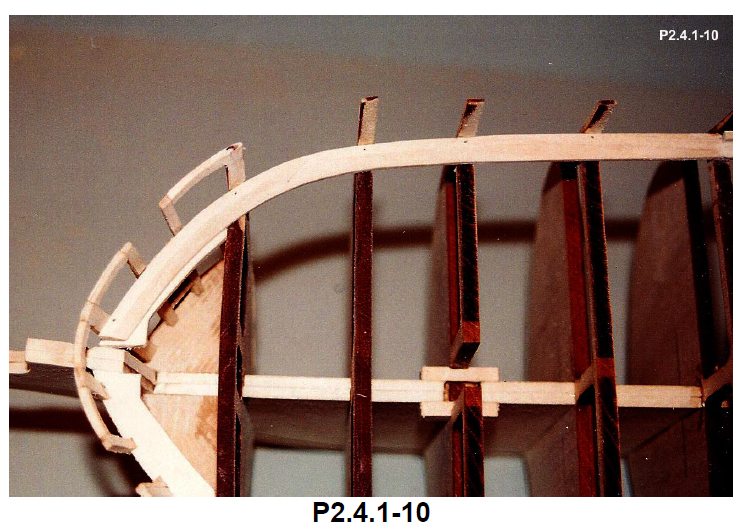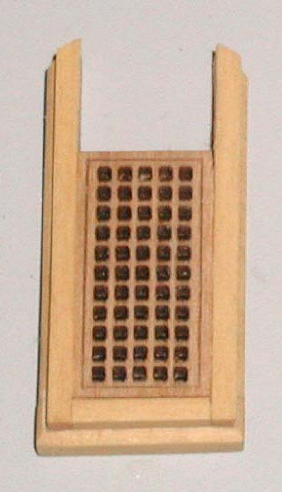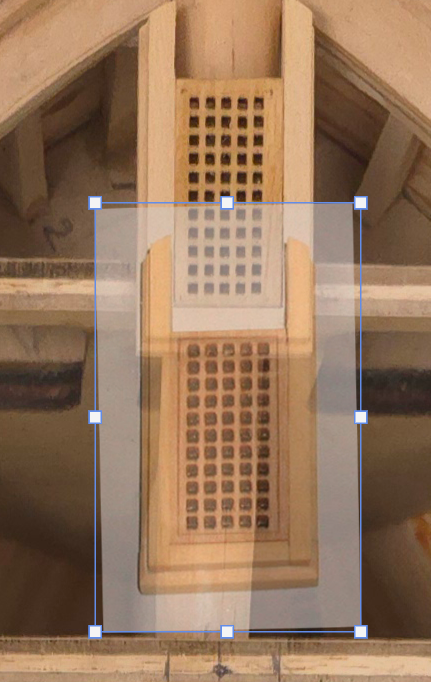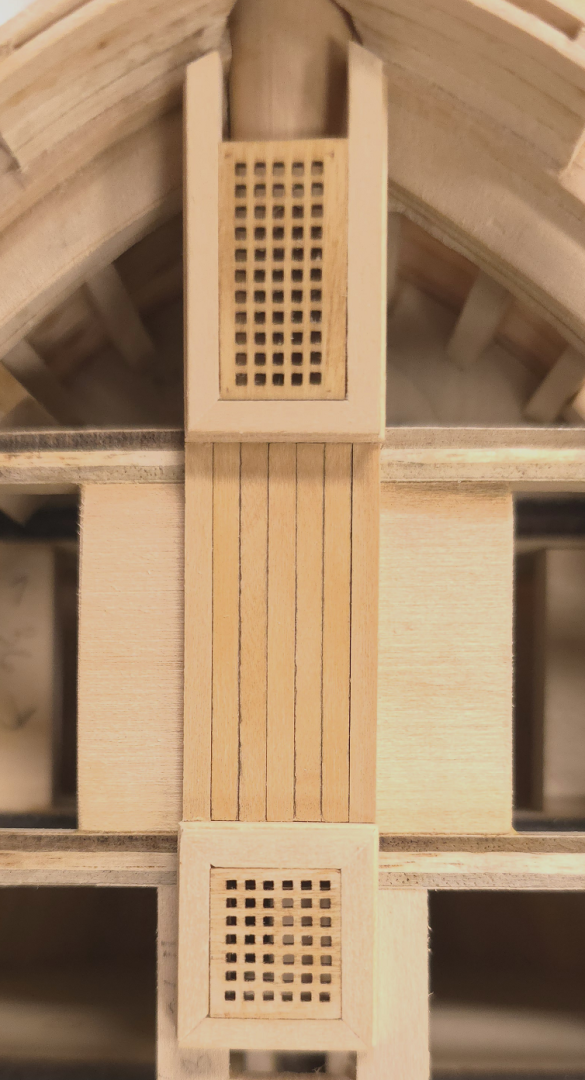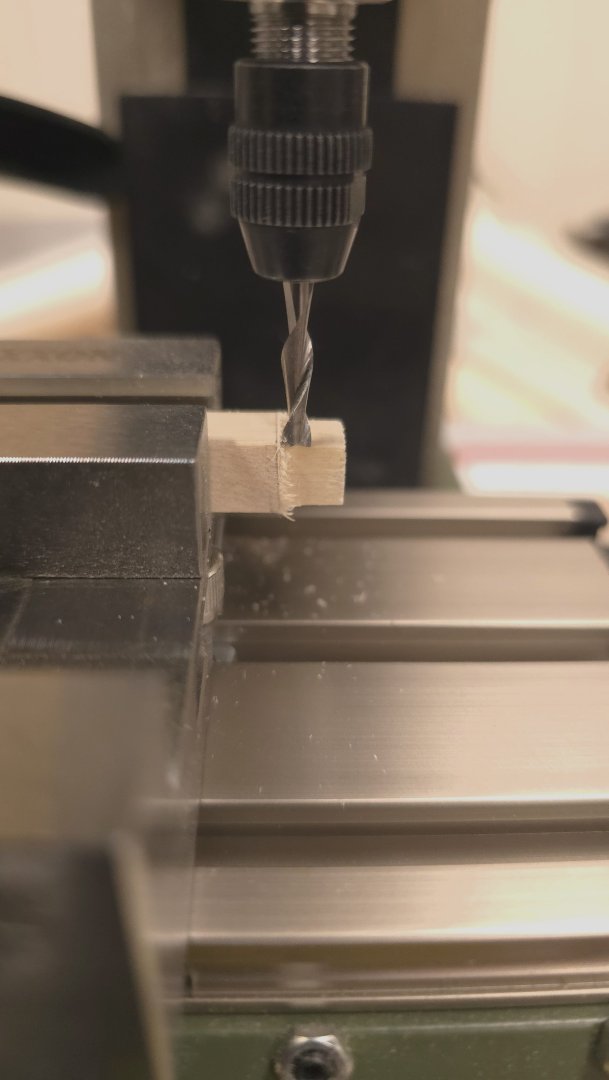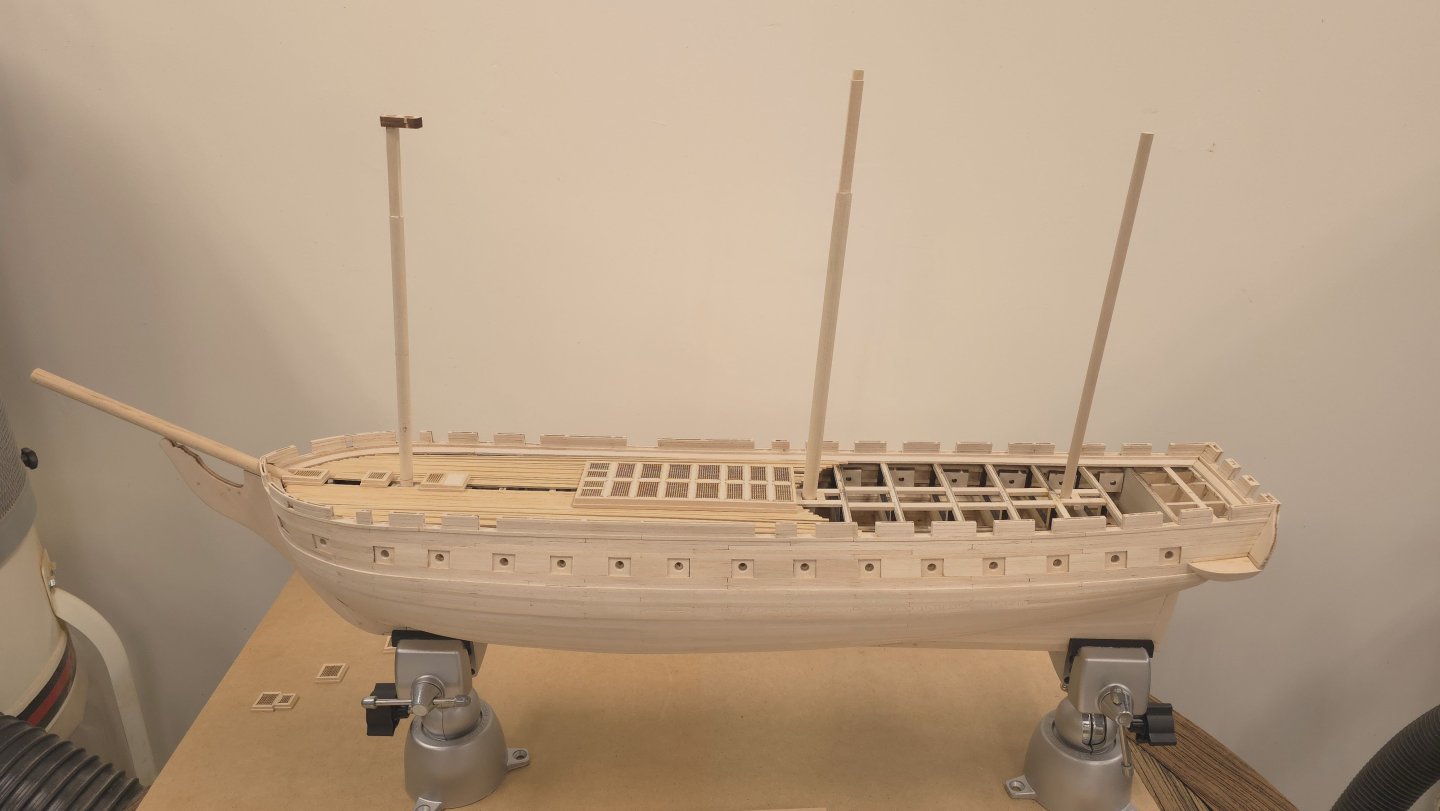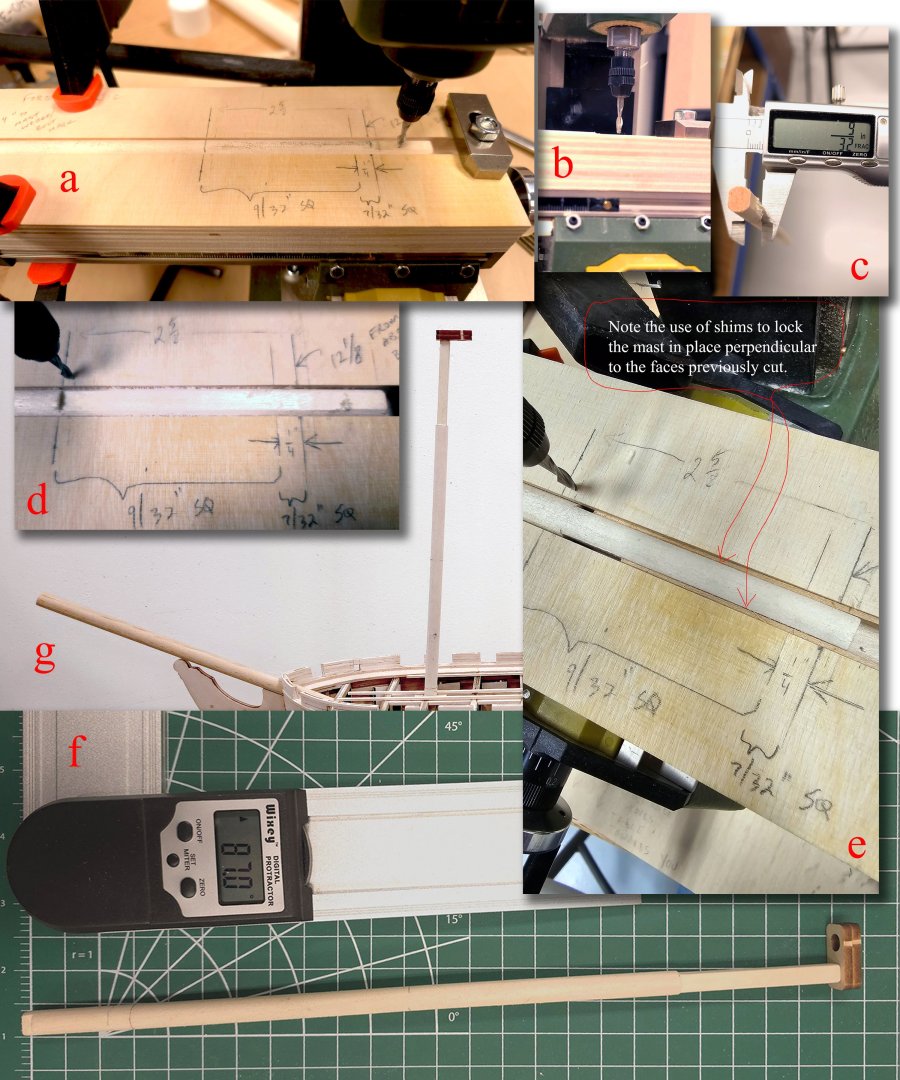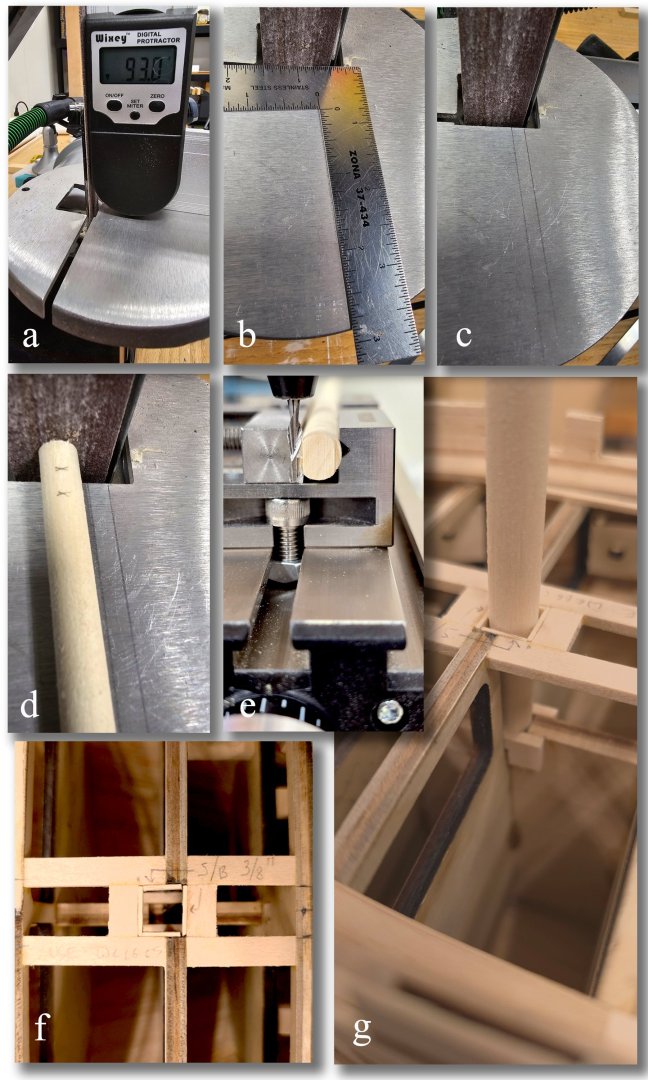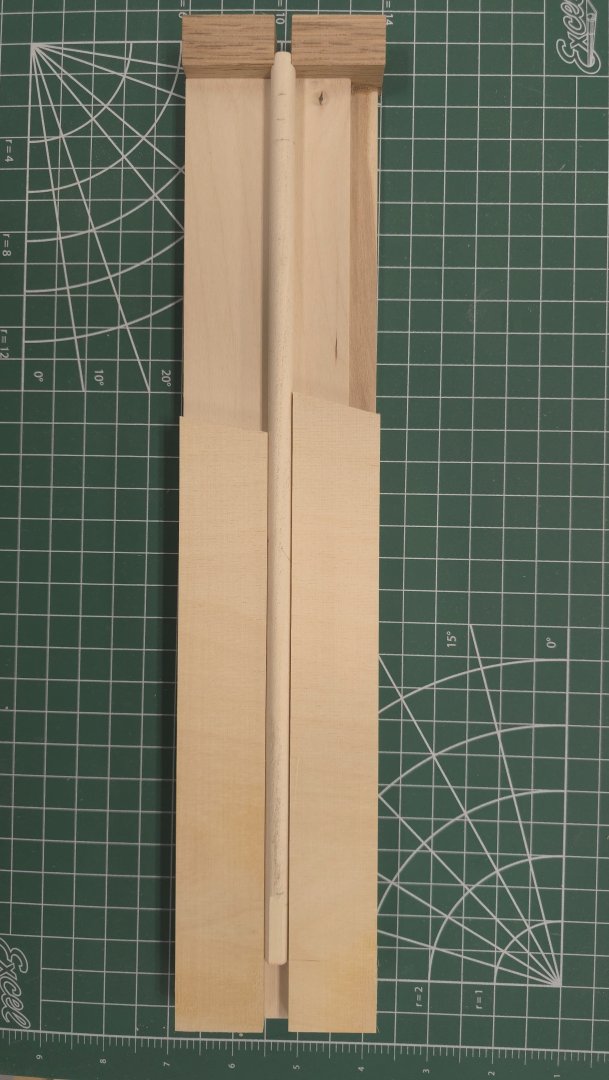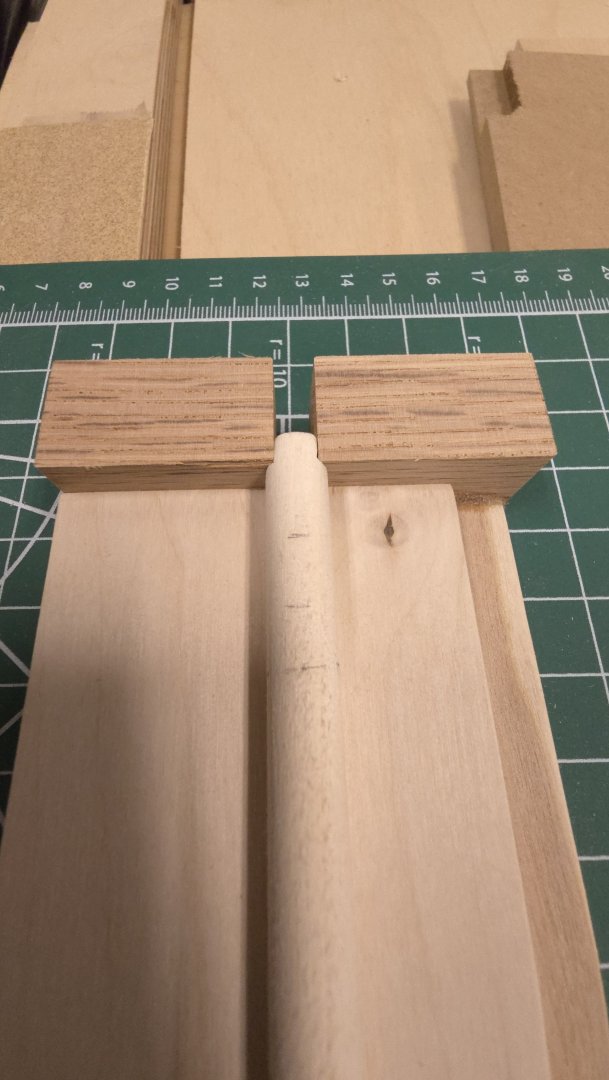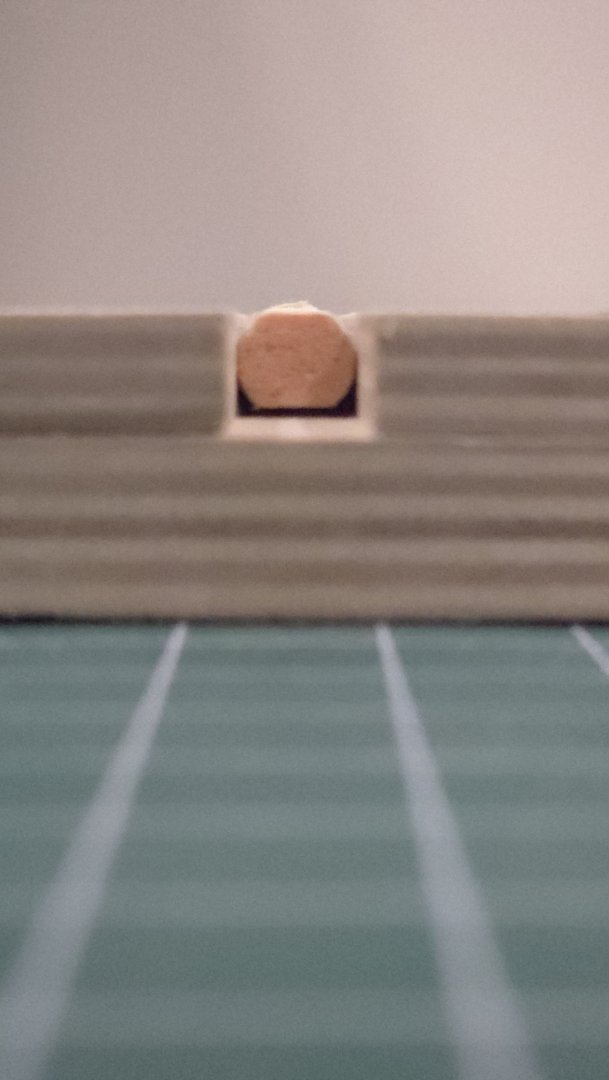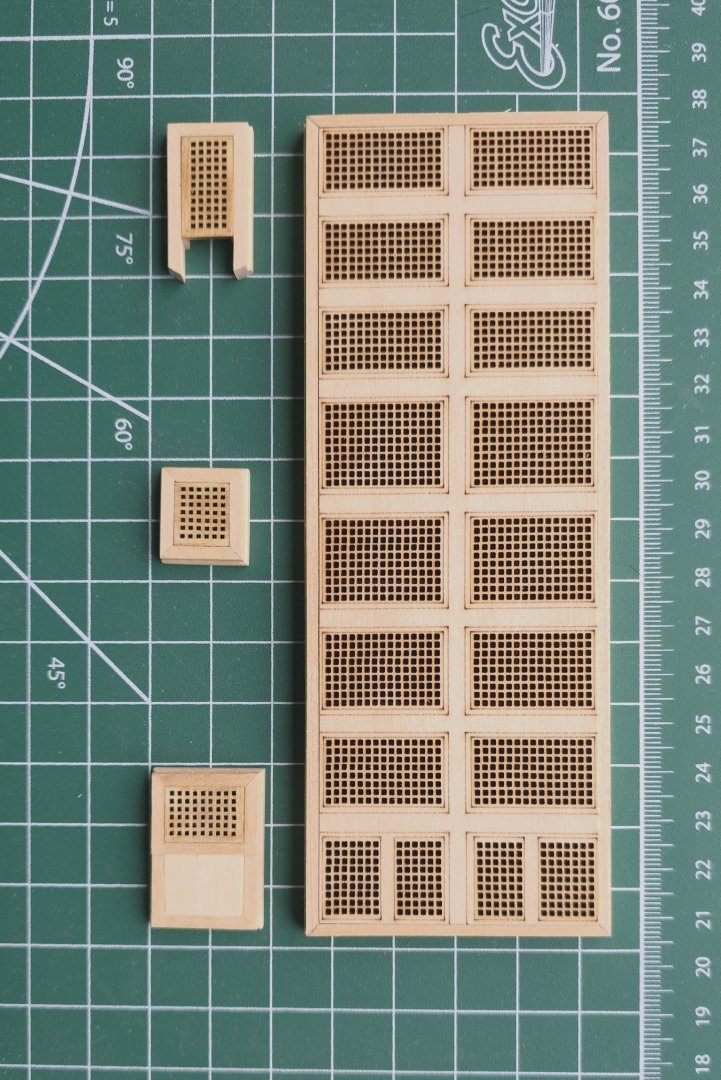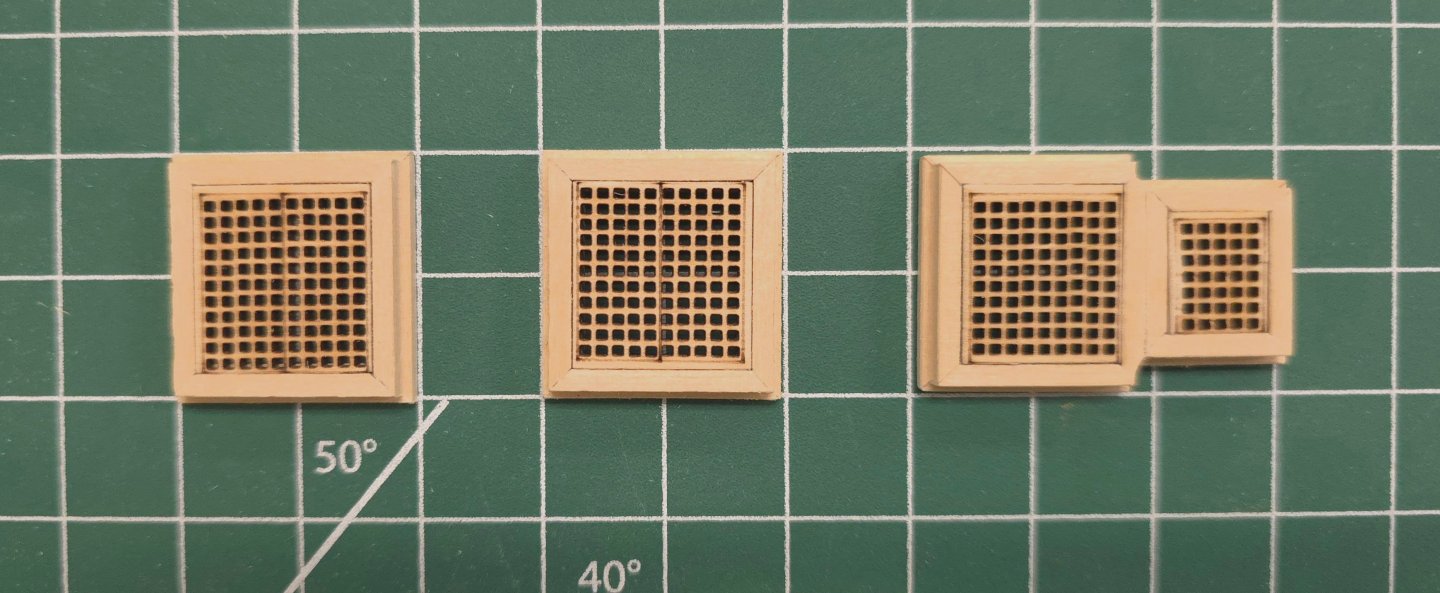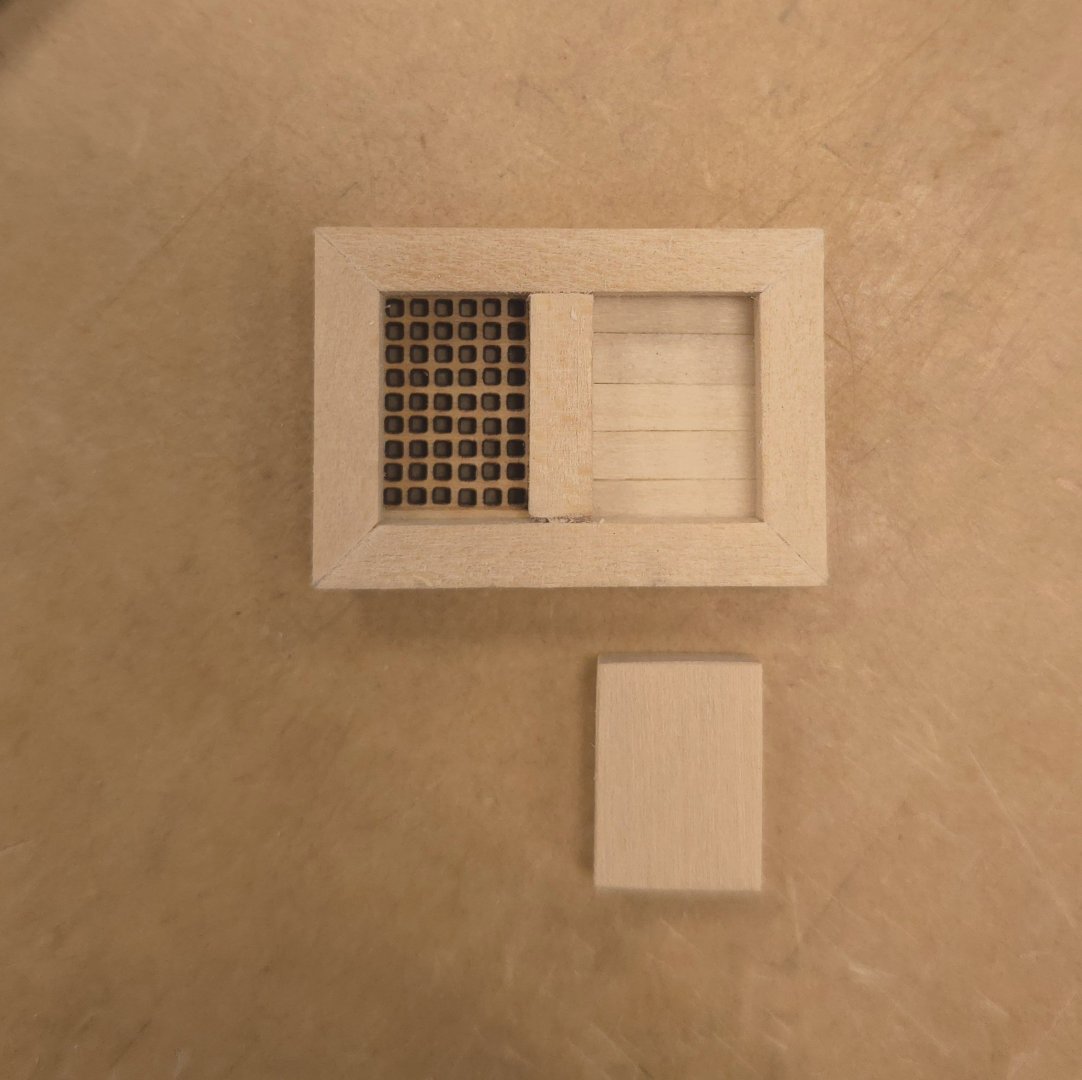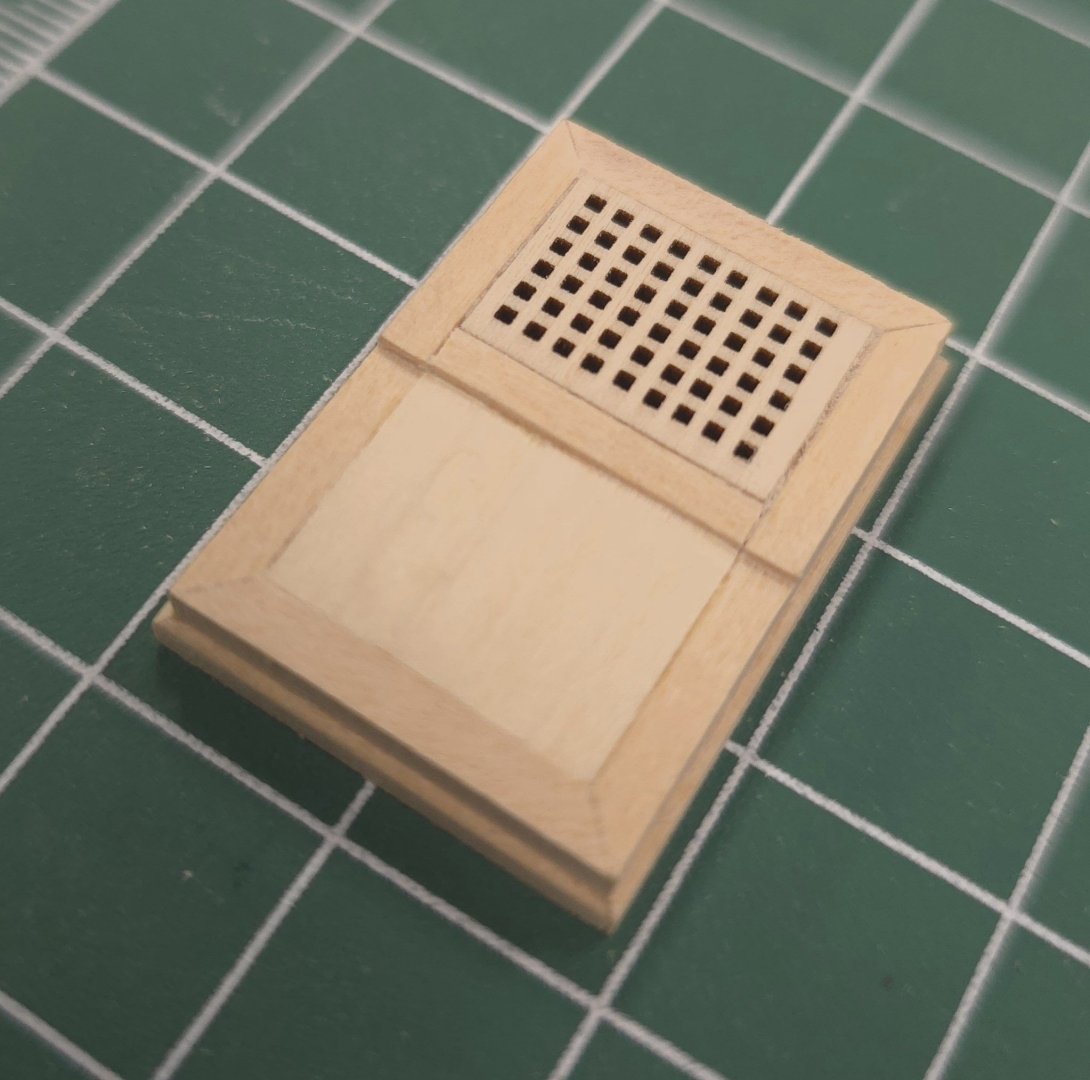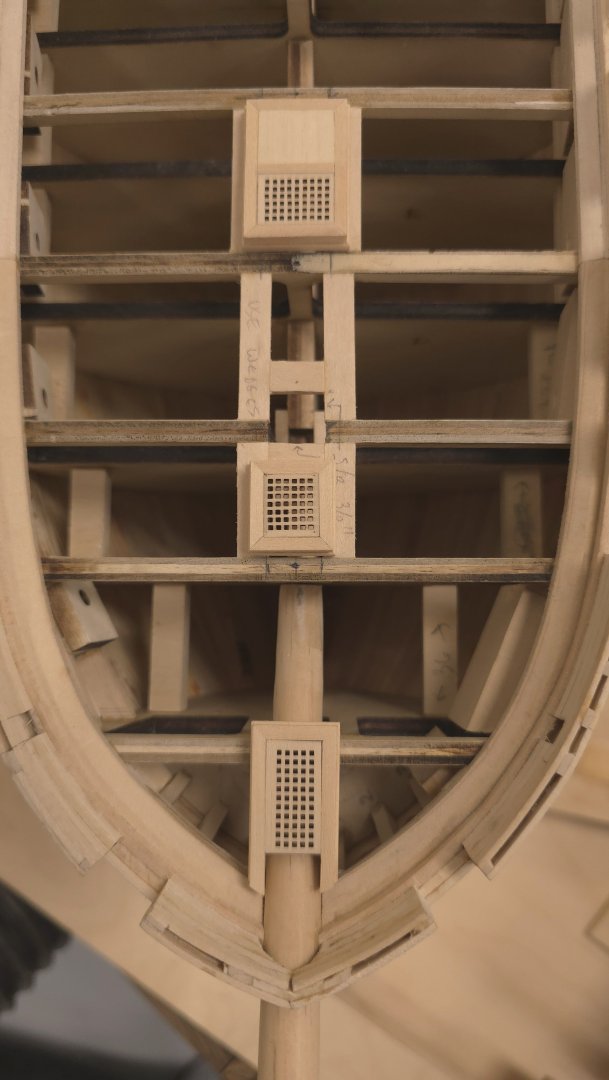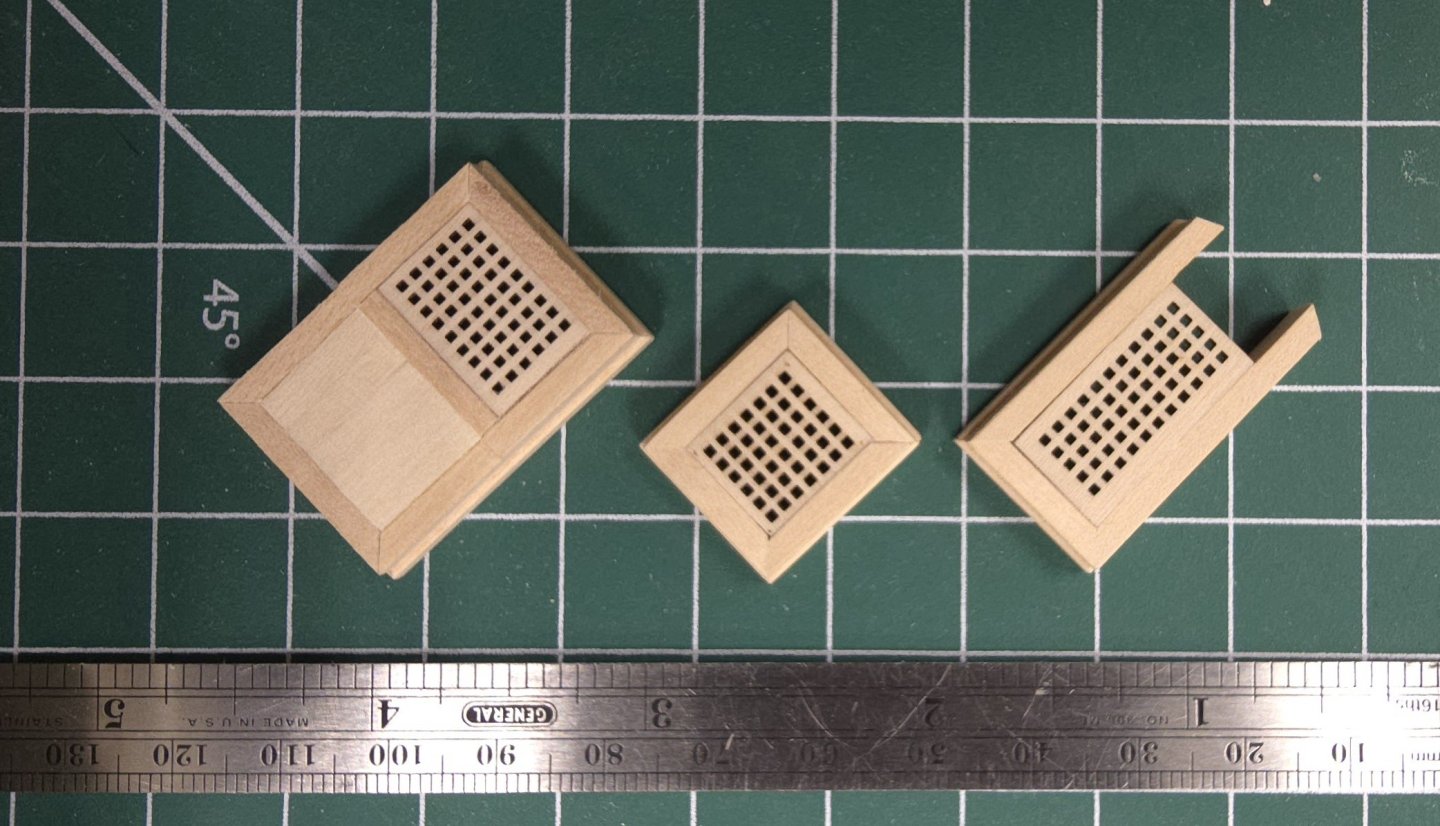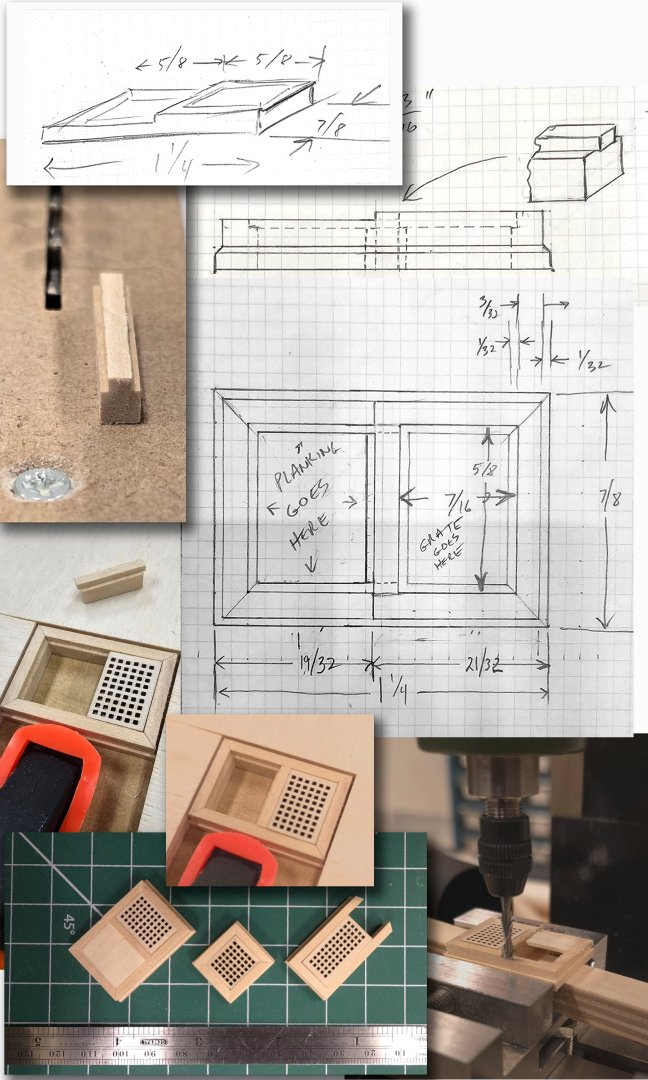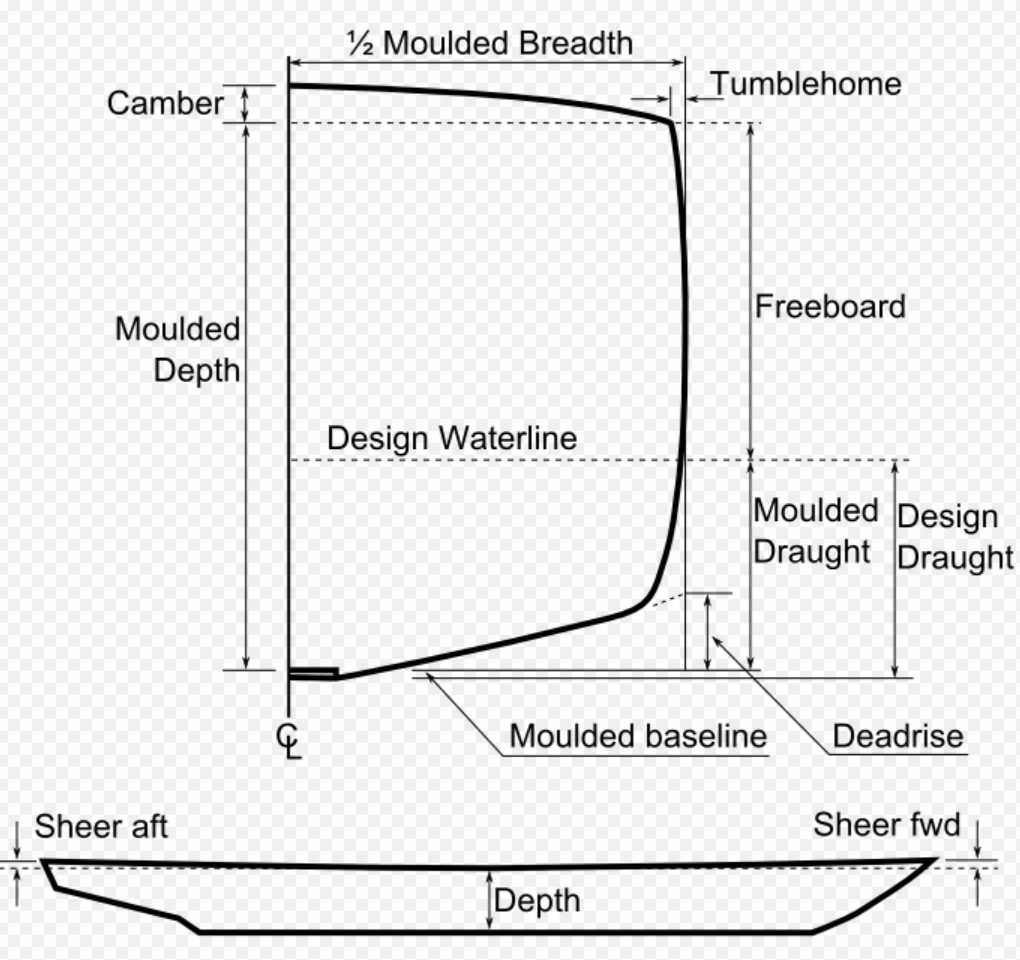-
Posts
846 -
Joined
-
Last visited
Content Type
Profiles
Forums
Gallery
Events
Everything posted by Der Alte Rentner
-
I hope that's what I just did by updating my post 14, Jon. So as to avoid sending you back there to see what I'm referring to, I'll recap here. I just started planking the spar deck and immediately became aware of several missteps early on in the build, that have compounded to give me grief now. When I constructed the bow framing, way back in Hunt's Chapter 2, I did not understand that spar deck planking needed to rest on the spar deck framing piece. Compounding that with my error in not constructing the waterway to plan, I am now faced with the need to construct a pair of filler blocks to make up for both the height difference and the loss of deck planking real estate at the bow. In retrospect, I think the spar deck frame pieces should have been made differently, sparing me the rework now. These photos should make clear the hole I dug for myself: 1. The problem today, showing the misshapen waterway, which resulted in the lost ledge to support the spar deck planks. 2. Clear 20/20 hindsight illustrated. Photo P 2.4.1-10 3. Photo 4.4.1-1 from Hunt's Chapter 4. 4. How maybe the spar deck frame could have been constructed to avoid the whole issue? Plan A (in red) gives you much more real estate for planking and to glue on the bowsprit hatch. Plan B (black dots) would probably have been sufficient, but perhaps there's something I don't know now about why Hunt added the undocumented framing pieces that magically appear in Chapter 4.
-
In reviewing XKen's build log, I read that he used "black glue" to simulate caulking between deck planks on the spar deck. I can't believe he would have used CA glue, which is all I can find online on a search. Does anyone know of a regular wood glue in black? Or did he just add black dye to something like Elmer's glue or Titebond? Thoughts?
-
Today I started work on planking the spar deck. As usual, reality didn't quite jive with the Hunt practicum. I double and triple checked the width of the bowsprit hatch and, just to make sure I wasn't hallucinating, I tried a little Photoshop experiment to see if I could spot the root cause of my problem. (Hunt hatch on left and superimposed over mine on the right. Nothing obvious. What is the problem, you ask? I used the 1/16” x 3/32” stock, as specified on page 50 of the practicum and confirmed by the plans. Yet, there seems to be a difference in the number of planks spanning the width of my hatches vs Hunt's. Seven planks (precisely cut by Modeller's Sawmill) don't quite span the width. I suspect that Hunt's stock may have been of the ilk as the typically off-sized material that came with my kit. (Yes, Mustafa, I learned my lesson! Next time I'll build from scratch.) Solution? It might simply be to shave a small fraction from the sides of hatches so the bordering planks sit flush. Whittling down matching carve-outs from the bordering planks would seem to be a waste of time. I'll go one thought further. I'm asking myself, Self, why not plank first and cut out openings for hatches and masts afterwards? (Actually, I may have an answer to that question. It might be easier to position the cutouts for the masts by planking to them vs. trying to find the exact locations to drill(?) holes to accommodate them later.) Another thought. Should I stain, at the very least, the bulwarks and waterways before doing ANY planking? I suppose I can postpone that decision a while longer, because the first round of planking won't approach the waterways anyway. By the way, I opted to use the side of a pencil lead to mimic the caulking used between the planks. I could probably even skip that if I used Titebond no. 2 or 3. This leaves behind a brownish seam which may suffice. I'll experiment with that the next time I'm in the shipyard, which won't be tomorrow, since I'll be having a crown fitted over the root canal I had done on Tuesday. Fun times.. 😁 (note the perfect teeth..)
-
In my experimentation with Acrylic paint, even un-thinned paint does not cover well in a single coat. When thinned to minimize brush marks when dry, no less than three coats were required to get a clean, smooth and uniform finish. When you mention surface prep, are you talking about readying the surface for gluing on additional pieces? or for the initial coat of paint? I'm concerned with the former, given the numerous features that will be affixed to the hull after painting. Thoughts? Advice?
- 184 replies
-
- Bluenose
- Model Shipways
-
(and 1 more)
Tagged with:
-
thus my reluctance to paint my Conny at all.. I'm about to embark on planking the spar deck but have been stalling while I consider finishing options. Hunt applies multiple coats of clear polyacrylic before he then covers that with multiple coats of paint, which he thins and applies with a brush. I experimented with stains, gel stains, and dyes as well as paint. After seeing how nicely black gel stain covered bare basswood, I had hoped I could use this over stained wood - the idea being, I would try some variant of brown stain on the hull and if I didn't like the result, I would cover the mess with black stain. Sadly, once the wood has taken a couple of coats of stain, the black gel doesn't cover well. So, if I decide I don't like the look of the brown stain, I will likely resort to - ugh! paint.. I have received advice to go with pinstripe tape masking and to use an air brush to get a better outcome with paint. Having seen so many spectacular close ups of brushed-on paint jobs, if I do paint, I'll be investing in yet another tool and accessories. Fun times ahead. 🤣 By the way, I still haven't tried gluing stuff to the experimental tiles I've prepared with poly and stain finishes. There are many items that need to be tacked on to the hull. How well does Super Glue stick to Hunt's 6 to 8 coat poly/paint finish on the hull? Upon further review: I was also asked why I don't cover the basswood hull planking with a different second layer, as if the norm for European kits. I do have the planking material from the Constructo kit, and I might achieve the natural wood finish I desire, but I'm not sure I'm up to the rigors of a second round of planking. 😒 Though, this would cover some of the flubs made on the first round. 🤔 Stalling, stalling, stalling... 😁 Nice work Gregg. As for the close up photos, I suspect that most viewers of your completed Bluenose won't be looking at her with magnifiers. It's amazing how little detail one's Mach 1 eyeballs pick up.
- 184 replies
-
- Bluenose
- Model Shipways
-
(and 1 more)
Tagged with:
-
I'll add to the list of constructive criticism for the practicum. It would really be nice to see photographs of Hunt's completed Constitution. Or even an uncompleted version with masts and bowsprit attached. If these exist, they are absent from my copy of the practicum. Has anyone got photos of the finished product?
-
I chime in with Gregg in recommending Modeler's Sawmill. I just received my third batch of wood from him, and I'm very pleased with the quality of the milling. Dimensions are spot on. As mentioned in my own build log, I wish I'd known (or even had an inkling) about replacing the subpar materials supplied with the kit when I started. Coulda, woulda, shoulda..
-
What went fairly smoothly on Wednesday, was a PITA today. I did knock off the two remaining mast partners, and cut the tenons at the bottom of the main and mizzen masts. This time, I took a short cut. Rather than place the mast partners where Hunt said to put them, I glued a piece of scrap wood to the underside of the framework between the bulkheads and more or less tacked it in position to nail the rake angle. Once that was done, I glued the cross members to the fore and aft framing. The masts now fit like a glove, and all sit at their correct respective angles/rakes. Then things went south. In keeping with the process I used to on the fore mast, I built a jig for the main mast, cut the fore and aft faces at the top to precisely 5/16", rotated the mast, and milled the sides. I have no idea how this happened, but these two faces ended up being 9/32" instead of the required 5/16". To boot, I lost track of where the shelf between the round portion of the mast met the squared off section needed to be, resulting in a 3/16" gouge on the starboard side of the mast. To fix this, I glued some scrap basswood to that side of the mast, trimmed away the excess and recut the offending face to net the correct thickness. Long winded way of saying, two steps forward, one step back? I did learn that I didn't need the jig to square off the top 1/4" of the mast. The vices with the Proxxon mill are short enough that I could simply clamp the square section down and mill away. I am quickly learning to convert fractions to metric in my head. And again, by going through this process now, I'm a leg up on Chapter 1 of Rigging the Constitution, when I finally get there.. Fore mast still needs a slight adjustment where the round part meets the square section to allow for the 3 degree rake. But the main mast is done. I just received the boxwood planking from Modeler's Sawmill. So to get a sense of where the next steps are heading, I staged the hull.. When I see the contrast between the boxwood and basswood, I really regret that I didn't know at the start to buy better materials.
-
Since, I'm waiting for box wood for the deck planking to arrive from Modeler's Sawmill, I took a small diversion to prove the concept outlined above by finishing the top of the fore mast. a. I marked the relevant dimensions on the face of my jig and mounted it to the table of my Proxxon mill. b. Then lowered the mill to be flush with the surface of the jig. c. Proved to myself that the math and the setup was correct. d. Milled the front and back face of the fore mast to net parallel sides 9/32" thick. I had to place a shim under the cut out section of the mast before milling the opposite side. The dowel material warped a bit with the first cut, so I had to prop that up. e. To get the other two faces milled, I rotated the mast 90 degrees and secured it in place with shims. Again, on the second pass, I had to place a shim under the previously trimmed side to support the mast while cutting the last face. I repeated the steps above to shave 1/32" off all four sides to net the 7/32" square notch for the mast caps. Some tweaking with a chisel was required afterwards to attain the 3 degree angled shelf for the mast caps to rest on. I did not glue these in place. f. The finished product. g. Test fitted the mast on Conny. Looking good, I think. a I'll probably repeat this process for the main and mizzen masts when dealing with their respective mast partners. I'll be a leg up when I get to Chapter 1 of Hunt's Rigging the Constitution - (next June?).
-
Hallo Nils, I noticed you looking in on Mtbediz's USS Constitution scratch build. Digging into your build list, I discovered your Gorch Foch. Ausgezeichnet! I too am working on the USS Constitution, my first build, but I have always wanted to build the Gorch Foch - or rather her sister ship, the Horst Wessel, which I believe is now the US Coast Guard cutter Eagle. My father told me that he spent six weeks aboard the Horst Wessel when he joined the Kriegsmarine in 1936. It's a long story, but the bottom line is that his experience during that time ultimately brought us to the United States. So, there's sort of a personal connection for me with this ship. It may take me another two years to finish the Constitution, but you have inspired me to tackle the Gorch Foch next! Vielen Dank Peter
- 222 replies
-
- gorch fock
- barque
-
(and 2 more)
Tagged with:
-
Oooh! I hope I remember this when it comes time to finish up the masts. - from XKen's build. In looking at the Hunt's Rigging the Constitution Chapter 1, I was dreading the thought of building the "chafing fish" out of Styrene. It appears that I won't have to! June 20, Hmmm Upon further reflection, and having just spent some quality time working with 1/16" x 3/32" planking as I begin spar deck planking, I'm wondering what tools or method XKen employed to achieve those clean angles "to match 90 degree surface". I can't think of any way to hold or clamp a strip to be able to cut a precise angle.
-
Before beginning deck planking, some housekeeping is required - namely the construction of the mast partners. I started with the foremast: a. Set the belt sander at 97 degrees to facilitate a 3 degree tilt as specified on page 6 of the plans. b. Mark the sander table with reference lines perpendicular to the belt itself. c. The lines are skewed to compensate for a poorly built belt sander. d. Sand the bottom of the mast. e. Use the Proxxon mill to create a 1/4" wide tenon in the center of the mast. With a little bit of math, and by carefully zeroing out the gauges on the Proxxon's X and Y handwheels, I was able to very accurately cut the tenon. A chisel was used to remove the rounded inside edge of the tenon. note: the belt sander left very noticeable sanding marks, which I used to eye-ball the piece vertically in the Proxxon vice. f. Correcting my error in not referring to the plan (I relied on the dimensions provided in the practicum), I added 1/32" shims to the mast partner opening for the foremast. This was necessary to accommodate the 3/8" mast diameter specified in the plan. Hunt had his students use 7/16" dowel. Does it matter? you may well ask.. It does, because the mast boot for the foremast has an inside diameter of 3/8". The 7/16" inside diameter boot is for the main mast. g. As luck would have it, the mast fit perfectly, right down to the 3 degree rake aft. There's no photo, but I did cut a paper template, per Hunt's suggestion, to verify the result. Working on the bottom end of the mast got me thinking about the 'rest of the story'. So, I looked ahead to Hunt's Rigging The Constitution, Chapter 1, to see what the top portion of the mast needed to look like. That left me wondering how best to carve that end of the mast down to 9/32" square at the other end. That in turn needed to be properly oriented with the tenon. So, I built a little jig to lock the mast's tenon end in on one side. The height of the channel to hold the mast in place was dimensioned such that I could use a flat chisel to shave off the right amount on each side to net two 9/32" parallel sides. I'll either find a way to attach the fixture to the Proxxon mill to cut the other two faces, or build another jig. For what it's worth, the jig only took a few minutes to construct out of scrap material lying around in my shop. My thickness drum sander came in handy to dial in the correct height. The hardest part was doing the math. 😉
-
Funny you should ask, Geoff. I didn't spend much time at the shipyard yesterday, but I did manage to mask the small error of sanding away the detail on those laser-cut hatches. Very light application of pecan gel stain. Not much else to say. Here's the evidence. and today, Wednesday June 5, after delays to to shipyard A/C going down, I finished the last of the hatch coamings. That last one was a royal PITA. The joinery came undone twice (super glue isn't that "super" on miter joint?) But it's done. Mast tenons and planking up next..
-
What I like about the Gorilla Glue product is the squeeze button on top (or two on the sides of the non-gel version). Let me know how squeezing these little tubes works for you - even with those syringe style tips attached. I get quite a bit of mileage out of one container. I believe I've only purchased three in a year, and I just started the 3rd one.
-
Especially when it came to masking over the eyebrow.. How you got such a fine straight line over the eyebrow is amazing - in and of itself. Part of the reason I don't want to paint Connie, is that I don't think I can manage a paintbrush well enough to do a decent job - not just the straight lines, but on the intricate work on the scroll work. Your build is looking good, looking forward to your coming back to it. No rush though, wait for me to catch up 😁
-
Thanks Geoff. I went to the shipyard this morning intending to start the main hatch. After a quick peek at the practicum, I was ready, willing and able to take the easy route by not cutting up the pre-fab laser cut grate provided in the kit. When I took a closer look at that large grate and how it would look in the coamings, I realized I probably should not have sanded the other grates smooth. Furthermore, I it dawned on me that these grates had a top and bottom side. Now that I know which side is up, I'll have to make sure I retain the detail in grate for the main hatch, which could be lost if I over sand. Live and learn.. By the way, how goes the rigging? and lastly, I checked out your Armed Virginia Sloop in the Gallery. Very nice!
-
Doing some research at the site to see how folks are dealing with hatch coamings, which I wish I'd done a little bit sooner. Seems as thought I should NOT have sanded the top side of the grates. But I digress. Too late for me, but I wish I'd thought about cutting the waterway to fit the cathead instead of the other way around. I haven't looked at your build in a while, but as I get further along in my build, that will change.
-
After a week's downtime, due in part to a pit bull attack, and exacerbated by a power failure that took my shipyard off line, I returned to work this morning and knocked off the galley stack hatch. (Chapter 4.3.4, if you're following along with the Hunt practicum.) As with the previous hatches, I found it easier to work with mitered corners than the lap joinery Hunt used. I realized after I was finished that I didn't need to produce another coaming piece. I could simply have used the same material I used to make the basic box, and filled the space under the planks on the stack side of the coaming with a slightly smaller filler block. Oh well.. I like the idea of the filler block because it made easy work of planking the stack end of the hatch. I just applied glue to five sides of the block and shoved it into the opening from the bottom. My router table was still setup from fabricating the strips I made for the two forward hatch coaming, so it took less than a minute to make the blank for the center piece. For that 1/32" overlap, I used the Proxxon mill to cut out the notch. Once the stack hatch coaming was assembled, I reduced the height of the stack side of the coaming by milling away 1/32". I little trimming here, a little sanding there, and viola, galley stack hatch done. Cutting the notch. Gally Stack Hatch Coaming from the bottom. Note the filler block below the coaming. I realized afterwards that I used 5 planks (3.2mm each) instead of the 7 Hunt used. Not worth it to me to correct that error.
-
whatever floats your boat.. Great fit! As I approach that part of the build where I need to fabricate and (dry) fit the mast, I may be coming around to your line of thinking when it comes to the tenons at the bottoms. I experimented with carving a tenon one end of a dowel and was not thrilled with the result. Even if the tenon is flush-mounted and reinforced with a nail after I test the fit, the method your brain preferred may indeed be the better option.
-
I am struggling to find the right word to describe the asymmetry between the port side and starboard side curves for the deck on the bulkheads. Camber? I had to shim up a couple of bulkheads so that there wouldn't be peaks or valleys when it came time to plank the deck. Checking the photo from above in post 170, I can see that the worst offenders were bulkheads D and P. Those needed to be to shimmed up on the port side of both. For bulkheads A and C, It seems that I trimmed the Starboard sides. I believe I laid planks on top of the bulkheads to find the high and low spots and/or asymmetry before trimming or adding to these four bulkheads. Hope that helps.
About us
Modelshipworld - Advancing Ship Modeling through Research
SSL Secured
Your security is important for us so this Website is SSL-Secured
NRG Mailing Address
Nautical Research Guild
237 South Lincoln Street
Westmont IL, 60559-1917
Model Ship World ® and the MSW logo are Registered Trademarks, and belong to the Nautical Research Guild (United States Patent and Trademark Office: No. 6,929,264 & No. 6,929,274, registered Dec. 20, 2022)
Helpful Links
About the NRG
If you enjoy building ship models that are historically accurate as well as beautiful, then The Nautical Research Guild (NRG) is just right for you.
The Guild is a non-profit educational organization whose mission is to “Advance Ship Modeling Through Research”. We provide support to our members in their efforts to raise the quality of their model ships.
The Nautical Research Guild has published our world-renowned quarterly magazine, The Nautical Research Journal, since 1955. The pages of the Journal are full of articles by accomplished ship modelers who show you how they create those exquisite details on their models, and by maritime historians who show you the correct details to build. The Journal is available in both print and digital editions. Go to the NRG web site (www.thenrg.org) to download a complimentary digital copy of the Journal. The NRG also publishes plan sets, books and compilations of back issues of the Journal and the former Ships in Scale and Model Ship Builder magazines.

